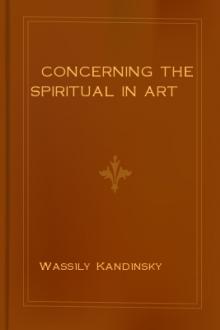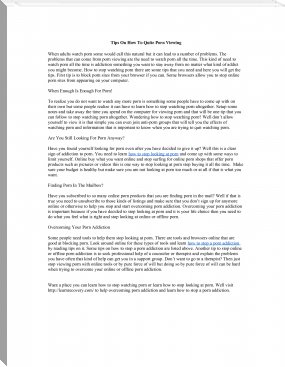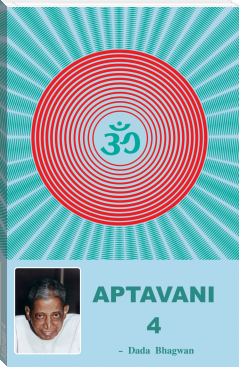Concerning the Spiritual in Art by Wassily Kandinsky (free romance novels TXT) 📖

- Author: Wassily Kandinsky
- Performer: -
Book online «Concerning the Spiritual in Art by Wassily Kandinsky (free romance novels TXT) 📖». Author Wassily Kandinsky
Often, many years after his body has vanished from the earth, men try by every means to recreate this body in marble, iron, bronze, or stone, on an enormous scale. As if there were any intrinsic value in the bodily existence of such divine martyrs and servants of humanity, who despised the flesh and lived only for the spirit! But at least such setting up of marble is a proof that a great number of men have reached the point where once the being they would now honour, stood alone.
II. THE MOVEMENT OF THE TRIANGLE
The life of the spirit may be fairly represented in diagram as a large acute-angled triangle divided horizontally into unequal parts with the narrowest segment uppermost. The lower the segment the greater it is in breadth, depth, and area.
The whole triangle is moving slowly, almost invisibly forwards and upwards. Where the apex was today the second segment is tomorrow; what today can be understood only by the apex and to the rest of the triangle is an incomprehensible gibberish, forms tomorrow the true thought and feeling of the second segment.
At the apex of the top segment stands often one man, and only one. His joyful vision cloaks a vast sorrow. Even those who are nearest to him in sympathy do not understand him. Angrily they abuse him as charlatan or madman. So in his lifetime stood Beethoven, solitary and insulted.
[footnote: Weber, composer of Der Freischutz, said of Beethoven’s Seventh Symphony: “The extravagances of genius have reached the limit; Beethoven is now ripe for an asylum.” Of the opening phrase, on a reiterated “e,” the Abbe Stadler said to his neighbour, when first he heard it: “Always that miserable ‘e’; he seems to be deaf to it himself, the idiot!”]
How many years will it be before a greater segment of the triangle reaches the spot where he once stood alone? Despite memorials and statues, are they really many who have risen to his level? [Footnote 2: Are not many monuments in themselves answers to that question?]
In every segment of the triangle are artists. Each one of them who can see beyond the limits of his segment is a prophet to those about him, and helps the advance of the obstinate whole. But those who are blind, or those who retard the movement of the triangle for baser reasons, are fully understood by their fellows and acclaimed for their genius. The greater the segment (which is the same as saying the lower it lies in the triangle) so the greater the number who understand the words of the artist. Every segment hungers consciously or, much more often, unconsciously for their corresponding spiritual food. This food is offered by the artists, and for this food the segment immediately below will tomorrow be stretching out eager hands.
This simile of the triangle cannot be said to express every aspect of the spiritual life. For instance, there is never an absolute shadow-side to the picture, never a piece of unrelieved gloom. Even too often it happens that one level of spiritual food suffices for the nourishment of those who are already in a higher segment. But for them this food is poison; in small quantities it depresses their souls gradually into a lower segment; in large quantities it hurls them suddenly into the depths ever lower and lower. Sienkiewicz, in one of his novels, compares the spiritual life to swimming; for the man who does not strive tirelessly, who does not fight continually against sinking, will mentally and morally go under. In this strait a man’s talent (again in the biblical sense) becomes a curse—and not only the talent of the artist, but also of those who eat this poisoned food. The artist uses his strength to flatter his lower needs; in an ostensibly artistic form he presents what is impure, draws the weaker elements to him, mixes them with evil, betrays men and helps them to betray themselves, while they convince themselves and others that they are spiritually thirsty, and that from this pure spring they may quench their thirst. Such art does not help the forward movement, but hinders it, dragging back those who are striving to press onward, and spreading pestilence abroad.
Such periods, during which art has no noble champion, during which the true spiritual food is wanting, are periods of retrogression in the spiritual world. Ceaselessly souls fall from the higher to the lower segments of the triangle, and the whole seems motionless, or even to move down and backwards. Men attribute to these blind and dumb periods a special value, for they judge them by outward results, thinking only of material well-being. They hail some technical advance, which can help nothing but the body, as a great achievement. Real spiritual gains are at best under-valued, at worst entirely ignored.
The solitary visionaries are despised or regarded as abnormal and eccentric. Those who are not wrapped in lethargy and who feel vague longings for spiritual life and knowledge and progress, cry in harsh chorus, without any to comfort them. The night of the spirit falls more and more darkly. Deeper becomes the misery of these blind and terrified guides, and their followers, tormented and unnerved by fear and doubt, prefer to this gradual darkening the final sudden leap into the blackness.
At such a time art ministers to lower needs, and is used for material ends. She seeks her substance in hard realities because she knows of nothing nobler. Objects, the reproduction of which is considered her sole aim, remain monotonously the same. The question “what?” disappears from art; only the question “how?” remains. By what method are these material objects to be reproduced? The word becomes a creed. Art has lost her soul. In the search for method the artist goes still further. Art becomes so specialized as to be comprehensible only to artists, and they complain bitterly of public indifference to their work. For since the artist in such times has no need to say much, but only to be notorious for some small originality and consequently lauded by a small group of patrons and connoisseurs (which incidentally is also a very profitable business for him), there arise a crowd of gifted and skilful painters, so easy does the conquest of art appear. In each artistic circle are thousands of such artists, of whom the majority seek only for some new technical manner, and who produce millions of works of art without enthusiasm, with cold hearts and souls asleep.
Competition arises. The wild battle for success becomes more and more material. Small groups who have fought their way to the top of the chaotic world of art and picture-making entrench themselves in the territory they have won. The public, left far behind, looks on bewildered, loses interest and turns away.
But despite all this confusion, this chaos, this wild hunt for notoriety, the spiritual triangle, slowly but surely, with irresistible strength, moves onwards and upwards.
The invisible Moses descends from the mountain and sees the dance round the golden calf. But he brings with him fresh stores of wisdom to man.
First by the artist is heard his voice, the voice that is inaudible to the crowd. Almost unknowingly the artist follows the call. Already in that very question “how?” lies a hidden seed of renaissance. For when this “how?” remains without any fruitful answer, there is always a possibility that the same “something” (which we call personality today) may be able to see in the objects about it not only what is purely material but also something less solid; something less “bodily” than was seen in the period of realism, when the universal aim was to reproduce anything “as it really is” and without fantastic imagination.
[Footnote: Frequent use is made here of the terms “material” and “non-material,” and of the intermediate phrases “more” or “less material.” Is everything material? or is EVERYTHING spiritual? Can the distinctions we make between matter and spirit be nothing but relative modifications of one or the other? Thought which, although a product of the spirit, can be defined with positive science, is matter, but of fine and not coarse substance. Is whatever cannot be touched with the hand, spiritual? The discussion lies beyond the scope of this little book; all that matters here is that the boundaries drawn should not be too definite.]
If the emotional power of the artist can overwhelm the “how?” and can give free scope to his finer feelings, then art is on the crest of the road by which she will not fail later on to find the “what” she has lost, the “what” which will show the way to the spiritual food of the newly awakened spiritual life. This “what?” will no longer be the material, objective “what” of the former period, but the internal truth of art, the soul without which the body (i.e. the “how”) can never be healthy, whether in an individual or in a whole people.
THIS “WHAT” IS THE INTERNAL TRUTH WHICH ONLY ART CAN DIVINE, WHICH ONLY ART CAN EXPRESS BY THOSE MEANS OF EXPRESSION WHICH ARE HERS ALONE.
III. SPIRITUAL REVOLUTION
The spiritual triangle moves slowly onwards and upwards. Today one of the largest of the lower segments has reached the point of using the first battle cry of the materialist creed. The dwellers in this segment group themselves round various banners in religion. They call themselves Jews, Catholics, Protestants, etc. But they are really atheists, and this a few either of the boldest or the narrowest openly avow. “Heaven is empty,” “God is dead.” In politics these people are democrats and republicans. The fear, horror and hatred which yesterday they felt for these political creeds they now direct against anarchism, of which they know nothing but its much dreaded name.
In economics these people are Socialists. They make sharp the sword of justice with which to slay the hydra of capitalism and to hew off the head of evil.
Because the inhabitants of this great segment of the triangle have never solved any problem independently, but are dragged as it were in a cart by those the noblest of their fellowmen who have sacrificed themselves, they know nothing of the vital impulse of life which they regard always vaguely from a great distance. They rate this impulse lightly, putting their trust in purposeless theory and in the working of some logical method.
The men of the segment next below are dragged slowly higher, blindly, by those just described. But they cling to their old position, full of dread of the unknown and of betrayal. The higher segments are not only blind atheists but can justify their godlessness with strange words; for example, those of Virchow—so unworthy of a learned man—“I have dissected many corpses, but never yet discovered a soul in any of them.”
In politics they are generally republican, with a knowledge of different parliamentary procedures; they read the political leading articles in the newspapers. In economics they are socialists of various grades, and can support their “principles” with numerous quotations, passing from Schweitzer’s EMMA via Lasalle’s IRON LAW OF WAGES, to Marx’s CAPITAL, and still further.
In these loftier segments other categories of ideas, absent in these just described, begin gradually to appear—science and art, to which last belong also literature and music.
In science these men are positivists, only recognizing those things that can be weighed and measured. Anything beyond that they consider as rather discreditable nonsense, that same nonsense about which they held yesterday the theories that today are proven.
In art they are naturalists, which means that they recognize and value





Comments (0)